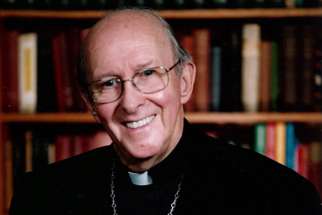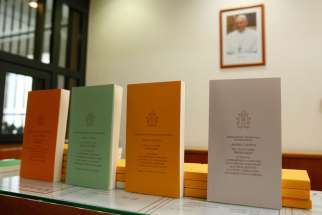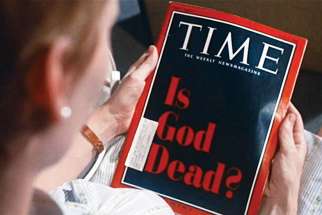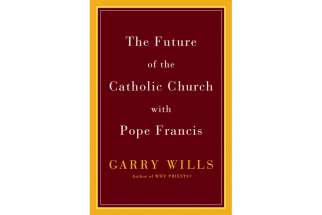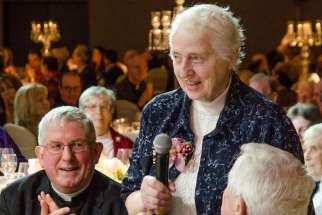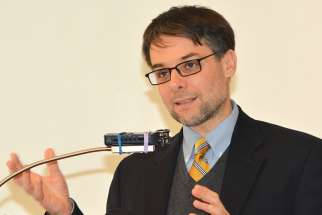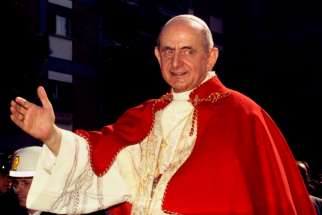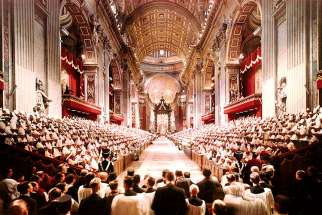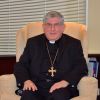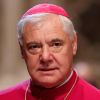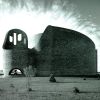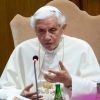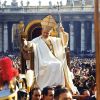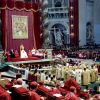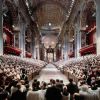Archbishop Hayes was a Council Father at Vatican II
OTTAWA – Archbishop-emeritus James Hayes, one of the last remaining Canadian participants from the Second Vatican Council, died in Halifax Aug. 2. He was 92.
Moving Vatican II forward
Pope Francis’ long meditation on love in the family does more than sum up two meetings of the world’s bishops in Rome in 2014 and 2015. Francis is bringing a new spark to an old fire.
WASHINGTON - It hit like the proverbial ton of bricks: the Time magazine cover story of April 8, 1966 — Good Friday that year — asking, “Is God Dead?”
Wills’ future stuck in the past
The Future of the Catholic Church with Pope Francis by Garry Wills. (Penguin, 288 pages, hardcover, $32.95)
At first glance, Garry Wills’ latest book might appear to offer insight into the life and intentions of Pope Francis. But anyone familiar with Wills’ polarizing views might well guess that is not the case. He does discuss Pope Francis — in the introduction and in the epilogue — but his treatment of the Pope is minimal.
VAUGHAN, ONT. - Sr. Andrea Dumont, a missionary Sister of St. Joseph, was honoured this year with Catholic Missions In Canada's St. Joseph Award.
Pope’s ‘popular mandate’ making enemies
EDMONTON - Pope Francis is a radical reformer who is facing enemies inside and outside the Church opposed to at least some parts of his agenda, says a prominent Church historian.
VATICAN CITY - Meeting Catholics from Pope Paul VI's home diocese, Brescia, Pope Francis said his predecessor's witness "nourishes within us the flame of love for Christ, love for the Church and the drive to proclaim the Gospel to the people of today with mercy, patience, courage and joy."
Calling Vatican II was an act of faith
VATICAN CITY - Blessed John XXIII called the Second Vatican Council in the conviction that it was necessary for the Catholic Church, yet without pre-conceived ideas of what it would accomplish, said Vatican II participants who recalled the event half a century later.
Vatican II remains relevant on campus, Collins says
TORONTO - The teachings of the Second Vatican Council may be more than 50 years old but they shouldn’t be regarded as irrelevant on today’s post-secondary campuses, said Cardinal Thomas Collins.
Reading Vatican II as break with tradition is heresy, prefect says
VATICAN CITY (CNS) -- Traditionalist and progressive camps that see the Second Vatican Council as breaking with the truth both espouse a "heretical interpretation" of the council and its aims, said the prefect of the Congregation for the Doctrine of the Faith.
A church built for Vatican II liturgy
There’s more to the liturgy than which words are spoken when and by whom. There’s more to it than can be captured by any one language, living or dead.
Architect Douglas Cardinal was one of the first to show the post- Vatican II liturgy in a church. As the Second Vatican Council ended, the now world-famous architect of Ottawa’s Canadian Museum of Civilization began work on his first internationally recognized masterwork — St. Mary’s Church in Red Deer, Alta.
The story of St. Mary’s encapsulates triumphs and tragedies of the Canadian Church against the backdrop of Vatican II ideals. The church was consecrated as a cathedral by the Oblate Archbishop Anthony Jordan of Edmonton in 1968, who attended all four sessions of the ecumenical council in Rome.
Cardinal grew up going to a residential school in the 1940s — St. Joseph’s Convent School in Red Deer. His father was Blackfoot and his mother Metis. He was one of the rare success stories — a smart kid who got top marks, excelled in art and music, studied piano at the Royal Conservatory of Music in Toronto.
He was also the head altar boy at St. Joseph’s and today as he pushes toward 80 years old he can still remember every word of the Latin Mass and can still sing the chants.
Cardinal’s brilliant career almost never happened. He was assaulted on the street as a young man in an ugly racial incident. In the Alberta of the late-1950s, it was naturally the native kid who wound up in jail. Jordan got him a lawyer, and helped get him out of jail.
From there, Cardinal travelled Europe — taking in everything from Antoni Gaudi’s Sagrada Familia Cathedral in Barcelona to the baroque San Carlo alle Quattro Fontane in Rome by his favourite architect, Francesco Baromini.
That was followed by more architecture studies at the University of Texas and travel through Mexico and the American southwest, where he saw adobe missionary churches that reminded him of one of the great 20th-century masterworks, Le Corbusier’s Chapelle Notre Dame du Haut in Ronchamp, France.
When German Oblate missionary Fr. Werner Merx tapped the young Cardinal to design a new church the priests didn’t know of the young architect’s history with his bishop. Merx stormed off to Edmonton prepared to battle Jordan for the chance to employ this brilliant young architect, not knowing how pleased his fellow Oblate would be to see the young man he saved from jail erect the first post-conciliar church in his diocese.
Merx and Cardinal weren’t just going to design a big building with some pews and a spire. They were going to invent a church based on the liturgy.
“We started by saying, what is the reason for the space?” Cardinal told The Catholic Register. “The altar.”
Merx insisted on a spare, unadorned sanctuary without even a cross. The pastor wanted the altar to be the sole symbol of the real presence, open and accessible to everyone gathered around it.
Every day at 4 p.m. Merx and Cardinal would meet at the church, play organ music and go over Cardinal’s designs. Their instruction manual was Sacrosanctum Concilium, Vatican II’s Constitution on the Sacred Liturgy. It took months to come up with the spare, unpolished altar that would dominate the sanctuary.
Cardinal designed a “light canon” — essentially a hole in the roof — over the altar.
“I wanted divine light coming from the altar,” he said. “That’s the sacrifice, the table of sacrifice. It should be the symbol of Christ. So light should emanate from the altar.”
The roof itself became a tent-like baldacchino hovering over the altar. Merx’s last church had burned down, so he wanted this one made of pure masonry and concrete. It was a tall order for a low roof.
“They told me it was impossible, with 81,000 simultaneous calculations to be solved. They said it would take 100 years,” recalled Cardinal.
The walls around the altar were laid out in a spiral form for the sake of acoustics.
“I want the sound of the Church to ring like a cathedral so that when the priest said ‘Dominus vobiscum’ it would go ‘Dominus vobiscum-um-um-um,’ ” he said. “Those beautiful Gregorian chants, I wanted them to sound properly in the church.”
Cardinal rooted his design in the spirit of baroque architecture, with its moving, dynamic forms.
“I felt the Church was better expressed by the Jesuit order, which was the baroque order, which was to bring some drama and power to the forms and shapes,” he said.
The result is something architecture students everywhere study, said Toronto architect Roberto Chiotti.
“Cardinal’s church in Red Deer always comes up as one of the case studies,” said Chiotti. “It’s very influential on the students and some of their designs.”
But Merx and Cardinal’s vision suffered in the post-Vatican II era. Merx was transferred to a northern mission almost as soon as the church was completed.
“Which really broke his heart,” said Cardinal. “He wanted to be there, but he was too liberal for the community.”
Subsequent pastors and parishioners found the design too austere and too far off the beaten path of regular Church architecture.
“No, they don’t get it. They put all those horrible statues in there. They’ve got... ugh!” Cardinal said.
At one point another architect was brought in to remove the baptistry from the entrance, where it had been a symbol of initiation into the church, and to make things a little more conventional. Cardinal tried to sue for the moral rights to his design, but the courts were reluctant to limit the parish’s right to dispose of its property.
When the church was built it stood alone on the horizon — a mysterious and beckoning shape. Today, it’s surrounded by a suburban subdivision with houses and schools. The bell tower still stands above the entrance, but the parish has never commissioned a peel of bells to occupy the trinity of open spaces left for them in the wall.
Despite all these disappointments and compromises, St. Mary’s made its mark.
“It’s captured in any historical anthology or survey of Canadian architecture. It would likely be in any major anthology of Church architecture because it’s so unique in its form,” said Chiotti. “Cardinal came along just at that moment when we were trying to articulate Vatican II and what does it mean. It’s a major transformation. He was a leader in trying to give tangible, meaningful expression to the documents as they would manifest themselves in Church architecture. It was very courageous and bold.”
Pope Benedict recalls Vatican II with praise and criticism
VATICAN CITY - On the eve of the 50th anniversary of the opening of the Second Vatican Council, L'Osservatore Romano, the Vatican newspaper, published a short reminiscence of the council by Pope Benedict XVI.
In the essay, the Pope recalls his presence at the opening of Vatican II, which he attended as a theological adviser. He both praises and criticizes some of the council's most consequential documents, regarding religious liberty and the Church's relationship with non-Christian religions and the modern world.
The essay is the introduction to a forthcoming collection of previously unpublished council-era writings by then-Father Joseph Ratzinger. The collection will be published in German this November.
"It was a moment of extraordinary expectation," the Pope writes of the procession of more than 2,000 bishops into St. Peter's Basilica Oct. 11, 1962. "Great things were about to happen."
"Christianity, which had built and formed the Western world, seemed more and more to be losing its power to shape society," he writes. "So that it might once again be a force to shape the future, (Blessed) John XXIII had convoked the council without indicating to it any specific problems or programs. This was the greatness and at the same time the difficulty of that task that was set before the ecclesial assembly."
A crucial question for the council fathers, Pope Benedict writes, was the "relationship between the Church and the modern world."
"From the 19th century onward," the Church had "visibly entered into a negative relationship with the modern era," he writes. "Did it have to remain so?"
Pope Benedict concludes that one of the council's best-known documents, "Gaudium et Spes," the Pastoral Constitution on the Church in the Modern World, failed to offer an adequate definition of the "essential features that constitute the modern era."
Instead, he writes, the "encounter with the great themes of the modern epoch" happened in "two minor documents, whose importance has only gradually come to light."
The Declaration on Religious Liberty, "urgently requested, and also drafted, by the American bishops in particular," clarified the Church's affirmation of the "freedom to choose and practice religion and the freedom to change it, as fundamental human rights and freedoms," he writes.
That declaration lent itself to troubling interpretations, the Pope writes, since it might seem to imply the "inaccessibility of the truth to man," which would make religion a merely subjective matter. But he writes that the 1978 election of Blessed John Paul II, from a country where the state denied religious freedom, revealed the "inner orientation of the faith toward the theme of freedom, and especially freedom of religion and worship."
The Pope also praises "Nostra Aetate," the council's declaration that the "spiritual, moral, and socio-cultural values (of non-Christian religions) were to be respected, protected and encouraged."
But the Pope writes that a "weakness of this otherwise extraordinary text has gradually emerged: It speaks of religion solely in a positive way, and it disregards the sick and distorted forms of religion."
In conclusion, Pope Benedict reiterates one of his most prominent teachings about Vatican II: that it must be interpreted in continuity with the Church's millennial traditions, not as a radical break with the past.
"The council fathers neither could nor wished to create a new or different Church. They had neither the authority nor the mandate to do so," he writes. "That is why a hermeneutic of rupture is so absurd and is contrary to the spirit and the will of the council fathers."
‘Reform’ the unspoken word at Vatican II
WASHINGTON - The Second Vatican Council was “animated by a spirit of reform,” but was afraid to use the word “reform,” Church historian Jesuit Father John O’Malley told a conference marking the 50th anniversary of the opening of the council.
In its 16 documents, Vatican II used the Latin word for reform, “reformatio,” only once — in its Decree on Ecumenism when it said the Church is in need of continual reform, said O’Malley, a professor in the theology department at Georgetown University. Other than that, it preferred “softer words,” such as renewal, updating or even modernizing, he said.
O’Malley was a keynote speaker Sept. 27 at the symposium “Reform and Renewal: Vatican II After Fifty Years” held at The Catholic University of America.
The Jesuit noted that Fr. Yves Congar, a French Dominican theologian and expert on ecumenism, wrote his book True and False Reform in the Church in the 1950s that “a veritable curse” seemed to hang over the word “reform.” And when Cardinal Angelo Roncalli, the future Pope John XXIII, heard of Congar’s book, he said, “Reform of the Church; is such a thing possible?”
The Vatican’s Holy Office forbade the reprinting of Congar’s book or its translation into other languages from the original French, he said. But during Vatican II, the priest was one of many theologians helping the bishops; Pope John Paul II made him a cardinal in 1994.
O’Malley traced the history of reform in early Church councils up to and including the 16th-century Council of Trent. Trent, however, coming on the heels of the Protestant Reformation, repeatedly insisted on the Church’s unbroken continuity with the faith and practice of the apostolic Church.
“In its insistence on continuity, Trent helped develop the tradition and fostered the Catholic mindset reluctant to admit change in the course of the Church’s history and teaching,” O’Malley told an audience of about 250 people.
“By the early 17th century, Catholic reluctance to see or admit change had become deeply rooted and pervasive.”
As well, Protestants had laid claim to the word “reform” as their own, he said. The word then “suffered banishment as foreign to Catholicism and subversive of it.”
That all changed in 2005 when, shortly after his election, Pope Benedict XVI gave a speech to the Roman Curia describing Vatican II as a council of reform, rather than one of rupture with the Catholic tradition, he said.
“Reform is, according to him, a process that within continuity produces something new,” O’Malley said. “The council, while faithful to the tradition, did not receive it as inert but as somehow dynamic.”
The Church, according to Pope Benedict, grows and develops in time, but nonetheless remains always the same, he said.
In another talk, Chad Pecknold, an assistant professor of historical and systematic theology at Catholic University, traced Pope Benedict’s aversion to theories of ruptures in Church history to his research into St. Bonaventure’s theology as the young Joseph Ratzinger.
St. Bonaventure was critical of the theory of the 12th-century monk Joachim of Fiore, who maintained that there are three eras in salvation history — the Old Testament age of the Father, the clergy-dominated era of the Son and the age of the Spirit in which spiritual men would hold first place and there would no longer be sacraments or a hierarchy.
Joachim predicted the age of the Spirit would begin in 1260, Pecknold said.
For St. Bonaventure and St. Thomas Aquinas, there could only be one rupture, humanity’s redemption in Jesus Christ, he said.
Moreover, not only was Joachim wrong about history, he also was wrong about God. His theory implied that the Father, Son and Spirit are three gods acting independently.
Pope Benedict, said Pecknold, sees any interpretation of Vatican II that separates the spirit of the council from its actual teaching is to see it in the same light as Joachim’s view of history. To interpret Vatican II as a rupture with the past is, for the Pope, an interpretation which is “bound to be church-dividing and is thus non-Catholic,” he said.
(Western Catholic Reporter)
What changed at Vatican II
Things changed with the Second Vatican Council. No one disputes that the Catholic faith remained what it has always been. The Church still teaches what the Church always taught. But the Council did not assemble 2,860 bishops to recite the catechism. The fact that the bishops commissioned the first authoritative catechism in 350 years was just one of many changes initiated at the Council.
Among the most important changes:
- Liturgy: Vernacular languages were encouraged, especially for Scripture readings at Mass, which became far more extensive with added Old Testament readings and a cycle of three years which focusses on each of the three synoptic Gospels (Matthew, Luke and Mark). By 1969 the Novus Ordo Mass allowed priests for pastoral reasons to face the assembly, gave the celebrant a variety of eucharistic prayers, restored the sign of peace to the entire congregation, allowed for distribution of both the body and blood of Christ under the forms of bread and wine and moved tabernacles off the altars to a noble and prominent location elsewhere in the church or a separate chapel. By 1973 the International Commission for English in the Liturgy produced the first official translation of the New Mass, though various provisional translations had been circulating since the end of the Council.
- Ecumenism: Unitatis Redintegratio declared the ecumenical movement a good thing, encouraged Catholics to be part of it and referred to Eastern, Oriental and Protestant Christians as "separated brethren." In 1928 Pope Pius XI had condemned the ecumenical movement. From the Council of Trent until the Second Vatican Council Protestants were officially referred to as heretics.
- Democracy and religious liberty: In Dignitatis Humanae the Church for the first time recognized the conscience rights of all people to freedom of religion, and declared it was the responsibility of states to protect religious freedom with stable laws. The idea that the state should be neutral in religion, or that liberal democratic states could be entrusted to protect human dignity or even that there was any such thing as a right to religious freedom, had been condemned by Pope Pius IX.
- Relations with Jews: "The Jews should not be presented as rejected or accursed by God," said Nostra Aetate. The charge of deicide was unfounded. The New Covenant is not possible without Abraham's stock.
- Relations with other religions: "The Church rejects nothing that is true and holy in these religions," said Nostra Aetate.
- Religious Life: Sisters, brothers and religious order priests were to do two things — rediscover the original purpose of their religious order and adapt it to the modern world, said Perfectae Caritatis.
- Canon Law: The Council fathers ordered a revised and written code of canon law that was finally delivered under Pope John Paul II in 1983.The Church’s past weaved into the future
The Second Vatican Council might be easier to understand if it had been called Back To The Future.
The two central ideas of the council appear to be headed in opposite directions. The first goes by a French title, resourcement, the second by an Italian one, aggiornamento.
Resourcement was a movement back in time. For half a century before the 1962-1965 council, theologians and many ordinary Catholics had been calling the Church back to its roots in Scripture, the early Church and even the Judaism of Jesus and His apostles. The Latin war cry on behalf of resourcement at the council was “Ad fontes!” (“To the sources!”), and one of its greatest advocates was Fr. Joseph Ratzinger. He would go on to interpret the council as a theologian, bishop, cardinal, prefect of the Congregation for the Doctrine of the Faith and now as Pope Benedict XVI.
Aggiornamento looked forward. It was how Pope John XXIII explained the basic impulse of the council. He wanted to open up the doors and windows of the Church and welcome in the world, to greet the modern age and all its cultural and technological revolutions with something more than suspicion, fear and rejection. The word means “up to the moment” in the sense of renewal.
Fifty years ago, the job of 2,860 bishops, with help from almost every significant theologian then living, was to weave the past and the future — resourcement and aggiornamento — into a seamless garment. As hard as the Church has worked to pull together those two impulses, other Catholics, conservative and liberal, have tried to pull them apart — or make one end of the spectrum more important than the other.
Liberal theologian Gregory Baum, who worked for Cardinal Augustin Bea at the Council, isn’t surprised that people want to downplay aggiornamento and all that it brought.
“There are people for whom religion means security. The world changes, everything changes, nothing is reliable,” Baum told The Catholic Register. “But the one thing that’s reliable and is unchanging is the religion they have inherited — not God, but the religion we have inherited.”
Change even small parts of their religion and you threaten people’s security, Baum said.
“It is a frightening thing,” he said.
Since the 1970s Fr. Alphonse de Valk, a conservative writer and founder of Catholic Insight magazine, has objected to the idea that the council could change the Catholic Church.
“I always supported the council,” de Valk said. “What I have attacked of course is the spirit of the council in which people said all sorts of silly things that were never discussed in the council... The ones I have opposed for these 50 years were the ones who said that the Vatican Council was a whole new beginning for the Catholic Church, and that this was something radically new, and we could forget everything we had ever been taught.”
Controversy over the council often obscures its historical context. It convened less than 20 years after the Second World War, in the shadow of the Cuban Missile Crisis, in the middle of the Cold War. At the same time, the council needs to be understood in the light of contemporary challenges to the Church, said Saint Paul University theologian and ecumenist Cathy Clifford.
“It’s probably more challenging today, even 50 years after Vatican II, because the Church is twice the size it was 50 years ago and now two-thirds of Catholics are in the southern hemisphere and non- European cultures,” she said.
From an African perspective, the Second Vatican Council was in a slightly different context. It came at the end of the colonial era, when more than 50 new nations were being born on that one continent.
“It has now become global. It’s the Church of the whole world,” Cardinal Peter Turkson told The Catholic Register. “We had a true representation of the world Church.”
For two generations after the council the African Church grew. Missionaries were replaced by local, African clergy. The continent went from 15,000 priests in 1962 to 40,000 in 2012. New dioceses with new bishops came into existence. The Novus Ordo Mass really is a new world order in Africa, with women and children dancing up the aisle to present the gifts and music that soars and thrills in natural three-part harmony pushed ahead by drums.
At the council the hierarchy of the Western Church — from the pope down through to deacons — invited the interaction of lay people. Just 24 years old in 1962, while studying theology at Toronto’s University of St. Michael’s College, Janet Somerville took up the invitation with joy and gusto. She witnessed the transformation from the days when people prayed rosaries while the Sunday readings poured off the ambo in Latin. Not just her mind, but her heart was opened by a sophisticated, scientific reading of the Bible rooted in history. At the same time, Catholics and Protestants were suddenly talking together about their faith.
“To me it felt as if the Catholic Church was renewing and reaffirming its rootedness in Scripture just in time to welcome much
more warmly the gifts of the Spirit that were flourishing in the Churches of the Protestant Reformation,” said Somerville. “I just rejoiced at that.”
She also rejoiced that a pope could cry “No More War” in an address to the entire world, as Pope John XXIII did in his encyclical Pacem in Terris. When the Vatican Council defined the Church in response to “The joy and hope, the grief and anguish of men of our time” in Gaudium et Spes, she knew it was just right.
Fifty years later it’s still just right, but bears reading again, she said. All that joy and optimism made it harder to see the full picture.
After a lifetime of work in religious journalism, a career as a CBC producer and as the first Catholic general secretary to the Canadian Council of Churches, Somerville has come to appreciate a little the conservative caution about Vatican II.
“Do I think we need more Catholic identity? Yes, I do,” she said. “But not because the Second Vatican Council wasn’t saying the things we need to know and the things we need to hear. It was. And not because we need to re-inculcate such a fear of the world and such a suspicion of the world that (the world’s) noble side and its great aspirations are as taboo in our homes as sexy advertising and consumerism and greed and living for the moment.”
There’s no shortage of people who wanted more out of the Second Vatican Council — more collegiality, more openness, more change, less centralization.
“By and large, certainly (the council) has been dealt some very serious blows,” said Jesuit Church historian John O’Malley.
But turning the counci l into a cultural battleground doesn’t advance the cause, said Clifford.
“I don’t know if disappointment is the kind of response that is helpful,” she said. “It is important to recognize that we haven’t fully received what the council taught. We haven’t fully implemented many of the structures that were provided for, even in the revision of the Code of Canon Law that followed the council. In some ways, we’ve received the council in a minimalist way.”
Hope is the response that Pope Benedict XVI has tried to foster.
“Many people have given up the fight. Many people have just lost interest, which is even worse,” said Somerville. “Pope Benedict XVI has a very interesting balance in the way he never rejects the council but does not put any short timelines on any of the victories we were confidently expecting.”
Hope was how it all started.
In 1959 Pope John XXIII first discussed with a few of his cardinals just what he had in mind. He told them: “I am thinking of the care of the souls of the faithful in these modern times... I am saddened when people forget the place of God in their lives and pursue earthly goods as though they were an end in themselves. I think, in fact, that this blind pursuit of the things of this world emerges from the power of darkness, not from the light of the Gospels, and it is enabled by modern technology. All of this weakens the energy of the spirit and generally leads to divisions, spiritual decline and moral failure. As a priest, and now as shepherd of the Church, I am troubled and aroused by this tendency in modern life and this makes me determined to recall certain ancient practices of the Church in order to stem the tide of this decline. Throughout the history of the Church, such renewal has always yielded wonderful results.”
The good pope was not speaking as a theologian, but as a pastor. A year into his own papacy, Pope Benedict gave a name to Pope John’s hopeful, pastoral impulse. He called it the “hermeneutic of reform.”
“With the Second Vatican Council the time came when broad new thinking was required. It’s content was certainly only roughly traced in the conciliar texts, but this determined its essential direction so that the dialogue between reason and faith, particularly important today, found its bearings on the basis of the Second Vatican Council,” he said.
Hermeneutic is a technical term in philosophy meaning a method of interpretation. Benedict famously contrasted interpretations of the Council based on reform with interpretations based on “discontinuity and rupture.” It is wrong to imagine the Church somehow started again in 1962, or that the Church before the Council was a different Church. There is only one mystical body of Christ, and it is the same through all time.


